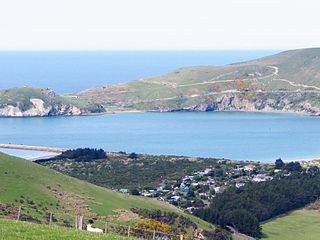
Aramoana is a small coastal settlement 27 kilometres (17 mi) north of Dunedin on the South Island of New Zealand. The settlement's permanent population in the 2001 Census was 261. Supplementing this are seasonal visitors from the city who occupy cribs. The name Aramoana is Māori for "pathway of the sea".

Dolichopodidae, the long-legged flies, are a large, cosmopolitan family of true flies with more than 7,000 described species in about 230 genera. The genus Dolichopus is the most speciose, with some 600 species.

Chrysotus is a genus of flies in the family Dolichopodidae. It is one of the largest genera in the subfamily Diaphorinae, with more than 460 species. However, the genus is probably paraphyletic, and possibly even polyphyletic, with respect to several related genera such as Achradocera, Falbouria and Lyroneurus.
Naufraga hexachaeta is a species of fly in the family Dolichopodidae. It is the only member of the genus Naufraga, and is found in New Zealand.
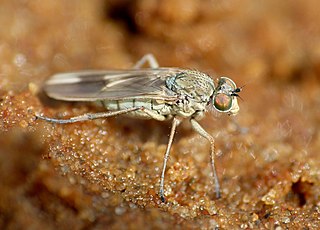
Scorpiurus is a genus of flies in the family Dolichopodidae, endemic to New Zealand. Members of the genus are found in marine littoral habitats.
Campsicnemus popeye is a species of carnivorous fly described in 2013. It was discovered from the Society Islands in French Polynesia. The species is named after the famous cartoon character Popeye the Sailor Man because of the enlarged tibia. The species is in fact among a group of six new species described as "Popeye flies". The specimen was collected in 2006 during an expedition to Tahiti.

Hydrophorinae is a subfamily of flies in the family Dolichopodidae. Several studies have found evidence that the subfamily in its current sense is polyphyletic.

Argyra diaphana is a species of fly in the family Dolichopodidae. It is distributed in Europe, except for the south.

Dolichopus lepidus is a species of fly in the family Dolichopodidae. It is found in the Palearctic.

Medetera petrophiloides is a species of fly in the family Dolichopodidae. It is found in the Palearctic.
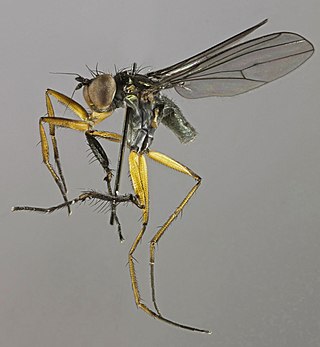
Campsicnemus scambus is a species of fly in the family Dolichopodidae. It is distributed in Europe, except for the south.
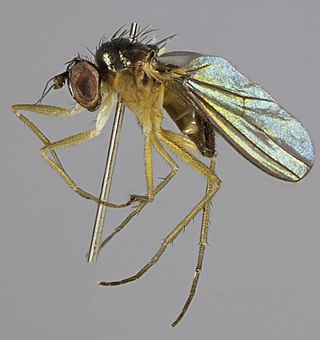
Anepsiomyia flaviventris is a species of fly in the family Dolichopodidae. It is found in Northwestern and central Europe, as well as in Portugal.

Parathalassiinae is a subfamily of flies in the family Dolichopodidae. It is part of an extended concept of the family, Dolichopodidae sensu lato, and forms a monophyletic group with Dolichopodidae sensu stricto. It was once placed provisionally in the subfamily Microphorinae as the tribe Parathalassiini.
Chimerothalassius is a genus of flies in the family Dolichopodidae. It contains five described species, two from New Zealand, two from New Caledonia and one from the Caribbean. It also contains three undescribed species, two from New Zealand and one from Costa Rica.
Tachytrechus sanus is a species of long-legged fly in the family Dolichopodidae.
Microphorites is an extinct genus of flies in the family Dolichopodidae.
Argyra leucocephala is a species of fly in the family Dolichopodidae. It is distributed in Europe, except for the southeast.
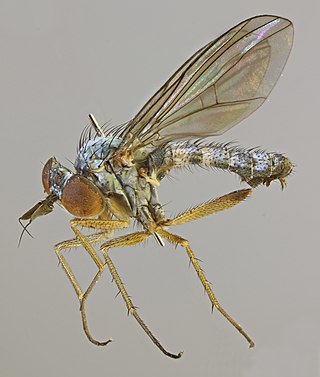
Argyra perplexa is a species of fly in the family Dolichopodidae. It is distributed in Northwestern Europe, Italy, Hungary and Portugal.

Argyra vestita is a species of fly in the family Dolichopodidae. It is distributed in Europe.













